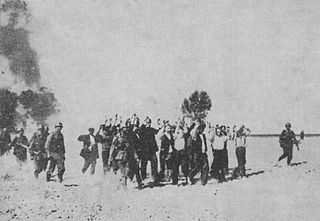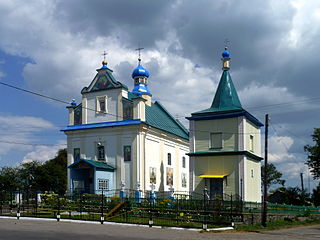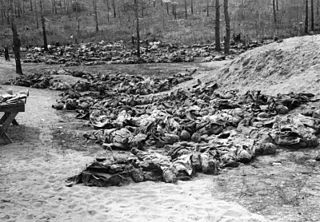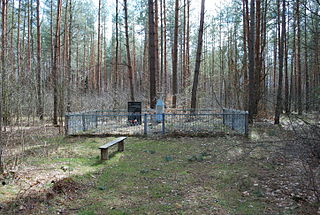Mass evacuation, forced displacement, expulsion, and deportation of millions of people took place across most countries involved in World War II. The Second World War caused the movement of the largest number of people in the shortest period of time in history. A number of these phenomena were categorised as violations of fundamental human values and norms by the Nuremberg Tribunal after the war ended. The mass movement of people – most of them refugees – had either been caused by the hostilities, or enforced by the former Axis and the Allied powers based on ideologies of race and ethnicity, culminating in the postwar border changes enacted by international settlements. The refugee crisis created across formerly occupied territories in World War II provided the context for much of the new international refugee and global human rights architecture existing today.
Żydokomuna is an anti-communist and antisemitic canard, or a pejorative stereotype, suggesting that most Jews collaborated with the Soviet Union in importing communism into Poland, or that there was an exclusively Jewish conspiracy to do so. A Polish language term for "Jewish Bolshevism", or more literally "Jewish communism", Żydokomuna is related to the "Jewish world conspiracy" myth.

Pacification actions were one of many punitive measures designed by Nazi Germany to inflict terror on the civilian population of occupied Polish villages and towns with the use of military and police force. They were an integral part of the war of aggression against the Polish nation waged by Germany since September 1, 1939. The projected goal of pacification operations was to prevent and suppress the Polish resistance movement in World War II nevertheless, among the victims were children as young as 1.5 years old, women, fathers attempting to save their families, farmers rushing to rescue livestock from burning buildings, patients, victims already wounded, and hostages of many ethnicities including Poles and Jews.
Ypatingasis būrys or Special Squad of the German Security Police and SD was a killing squad operating in the Vilnius Region in 1941–1944. The unit, primarily composed of Lithuanian volunteers, was formed by the German occupation government and was subordinate to Einsatzkommando 9 and later to Sicherheitsdienst (SD) and Sicherheitspolizei (Sipo).p.15 The unit was subordinated to German police, and had no official autonomy. In Polish they were colloquially called strzelcy ponarscy.

A sybirak is a person resettled to Siberia. Like its Russian counterpart sibiryák the word can refer to any dweller of Siberia, but it more specifically refers to Poles imprisoned or exiled to Siberia or even to those sent to the Russian Arctic or to Kazakhstan in the 1940s.
The Parczew partisans were fighters in irregular military groups participating in the Jewish resistance movement against Nazi Germany and its collaborators during World War II. The name of the partisan force, coined by the Holocaust historians, is borrowed from the Parczew forest located a short distance away from Lublin, halfway to the town of Sobibór, the location of the Sobibór extermination camp during the Holocaust in occupied Poland. The Jews who managed to escape from the camp hid in there along with the considerable number of Jewish families of the Lublin Ghetto.

Pavlivka is a town now located in northwestern Ukraine, in Volodymyr Raion of Volyn Oblast, near Volodymyr, on the Luha river. For centuries, Poryck was property of several noble Polish families. The town is the birthplace of a Polish statesman Tadeusz Czacki. On 11 July 1943, the Ukrainian Insurgent Army, supported by local nationalists murdered here more than 300 Polish civilians, who had gathered in a local Roman Catholic church for a Sunday ceremony.

Amnesty for Polish citizens in USSR was the one-time amnesty in the USSR for those deprived of their freedom following the Soviet invasion of Poland in World War II. The signing of amnesty by the Presidium of the Supreme Soviet on 12 August 1941, resulted in temporary stop of persecutions of Polish citizens under the Soviet occupation. Their mass persecution accompanied the 1939 annexation of the entire eastern half of the Second Polish Republic in accordance with the Nazi-Soviet Pact against Poland. In order to de-Polonize all newly acquired territories, the Soviet NKVD rounded up and deported between 320,000 and 1 million Polish nationals to the eastern parts of the USSR, the Urals, and Siberia in the atmosphere of terror. There were four waves of deportations of entire families with children, women and elderly aboard freight trains from 1940 until 1941. The second wave of deportations by the Soviet occupational forces across Kresy, affected 300,000 to 330,000 Poles, sent primarily to Kazakh SSR. The amnesty of 1941 was directed specifically at Polish victims of those deportations.

In the aftermath of the German and Soviet invasion of Poland, which took place in September 1939, the territory of Poland was divided between Nazi Germany and the Soviet Union. The Soviets had ceased to recognise the Polish state at the start of the invasion. Since 1939 German and Soviet officials coordinated their Poland-related policies and repressive actions. For nearly two years following the invasion, the two occupiers continued to discuss bilateral plans for dealing with the Polish resistance during Gestapo-NKVD Conferences until Germany's Operation Barbarossa against the Soviet Union, in June 1941.

Zygmunt Jan Rumel was a Polish poet and, during World War II, underground officer of the Bataliony Chłopskie partisans in the Wolhynia Region of the Second Polish Republic. Rumel's poetic talent was acknowledged by renowned Polish poet Leopold Staff and dramatist Jarosław Iwaszkiewicz. One of his poems entitled "Dwie matki" in which Rumel described his love of Poland and Ukraine, was published in a popular Płomyk magazine in 1935. He was killed by the Ukrainian Insurgent Army during the massacres of Poles in Volhynia in 1943.

The Polish census of 1931 or Second General Census in Poland was the second census taken in sovereign Poland during the interwar period, performed on December 9, 1931 by the Main Bureau of Statistics. It established that Poland's population amounted to almost 32 million people.
The village of Adamy was burned to the ground during the Massacres of Poles in Volhynia and Eastern Galicia, and no longer exists. It was destroyed by the Ukrainian Insurgent Army aided by the Ukrainian peasants who set ablaze 200 Polish farms and murdered whomever they could find. Adamy was located in powiat Kamionka Strumiłowa (county) near Busk in the Tarnopol Voivodeship of the Second Polish Republic before the Nazi-Soviet invasion of Poland in 1939.

Bortnytsia is a village in Rivne oblast, near the town of Dubno, in Dubno Raion, Ukraine. The village currently has a population of 365.
Pańska Dolina no longer exists. The village was liquidated during the Polish population transfers after World War II, when the Kresy macroregion was formally incorporated into the Soviet Union. Pańska Dolina used to be located in Gmina Młynów, Powiat Dubno (county), of the Wołyń Voivodeship, before the Nazi German and Soviet invasions of Poland in September 1939. Its former location can be found near Mlyniv in Dubno Raion of present-day Ukraine.
Massacre of Wola Ostrowiecka was a 1943 mass murder of Polish inhabitants of the village of Wola Ostrowiecka located in the prewar gmina Huszcza in Luboml County of the Volhynian Voivodeship, within the Second Polish Republic. Wola Ostrowiecka no longer exists. It was burned to the ground during the Massacres of Poles in Volhynia and Eastern Galicia.

The Parośla I massacre was committed during World War II by the Ukrainian Insurgent Army (UPA) under the command of Hryhorij Perehijniak "Dowbeszka-Korobka" on 9 February 1943 against the ethnic Polish residents of the village of Parośla in the Nazi-controlled Reichskommissariat Ukraine. It is considered a prelude to the ethnic cleansing of Poles in the Volhynia region by the UPA, and is recognized as the first mass murder committed by the Ukrainian Insurgent Army in the area. Estimates of the number of victims range from 149 to 173.

Było sobie miasteczko... is a 2009 Polish historical documentary film about the 1943 Kisielin massacre in the village of Kisielin, located in the Wołyń Voivodeship in Poland before World War II,. The film, directed by Tadeusz Arciuch and Maciej Wojciechowski, was produced by Adam Kruk for Telewizja Polska.

Around 6 million Polish citizens perished during World War II: about one fifth of the pre-war population. Most were civilian victims of the war crimes and crimes against humanity during the occupation by Nazi Germany and the Soviet Union. Approximately half were Polish Jews killed in The Holocaust. Statistics for Polish World War II casualties are divergent and contradictory. This article provides a summarization of these estimates of Poland's human losses in the war and their causes.

The occupation of Poland by Nazi Germany and the Soviet Union during World War II (1939–1945) began with the Invasion of Poland in September 1939, and it was formally concluded with the defeat of Germany by the Allies in May 1945. Throughout the entire course of the occupation, the territory of Poland was divided between Nazi Germany and the Soviet Union (USSR), both of which intended to eradicate Poland's culture and subjugate its people. In the summer-autumn of 1941, the lands which were annexed by the Soviets were overrun by Germany in the course of the initially successful German attack on the USSR. After a few years of fighting, the Red Army drove the German forces out of the USSR and crossed into Poland from the rest of Central and Eastern Europe.
Poland’s Holocaust: Ethnic Strife, Collaboration with Occupying Forces and Genocide in the Second Republic, 1918–1947 is a 1998 book by sociologist Tadeusz Piotrowski. It concerns the topic of Poland's history in the interwar period as well as in World War II, with particular focus on the uneasy relations between various ethnic groups of the Second Polish Republic.











